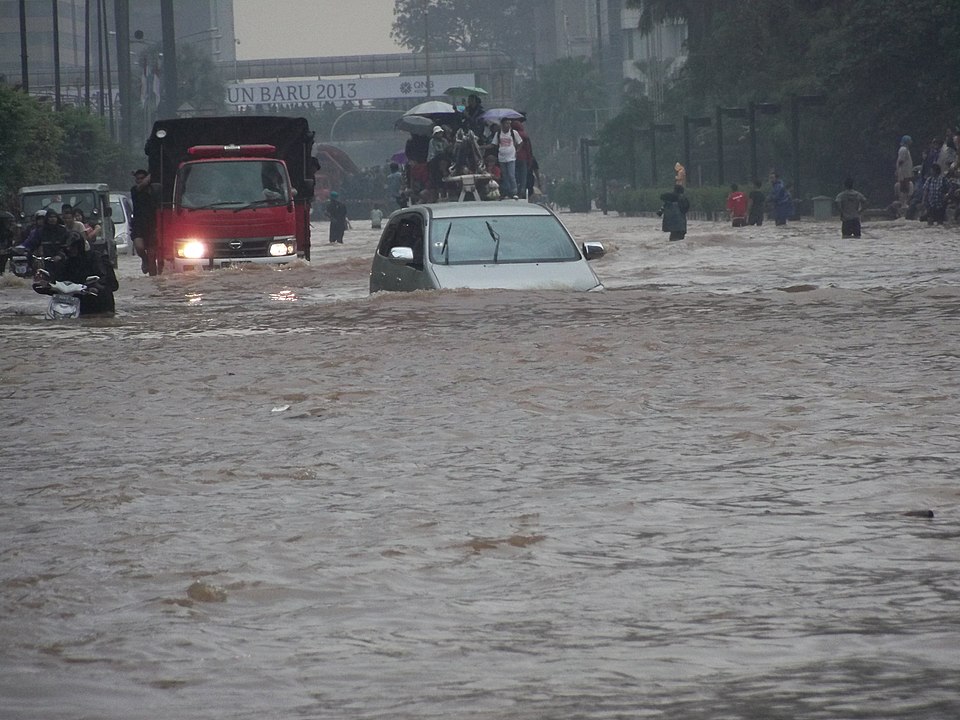
Why is Jakarta sinking? Jakarta is sinking by as much as 30 cm a year in some places, and the cause is overextraction of groundwater.
Jakarta is the capital city of Indonesia, and home to 11.3 million people, which is roughly 4% of all Indonesians. It is on the northwest coast of Java and is built on a delta. 13 rivers head through the area to reach the sea. The whole area is an alluvial plain, which is a piece of land created by sediment that has been deposited by rivers. Alluvial plains are usually prone to flooding, and these floods deposit more sediment.
People have lived in the area since roughly 400 BC, and by the 13th century AD, it had become a port town. The majority of the people living in the area worked on farms, and they built their houses on stilts to keep them away from the water during floods. The rulers of the area managed to drain and irrigate large parts of the land. Then the Dutch arrived in 1596, and the city gradually began to grow. As in Holland, they built canals to regulate the course of the rivers and to try to control the flooding. This may have made the problem worse, but people started to move into the area. However, it was only when independence was declared after World War 2 that the population really began to grow. In 1950, the population was 1.5 million people, and it has increased roughly by 150,000 people a year to reach its current 11.3 million people. The main reason for this rise was mass urbanization. Many of the people who worked the land in Java and on many of the other islands moved to the city for work. This created several problems, one of which is mainly responsible for the city sinking.
The city grew faster than its infrastructure could or would cope with. The majority of the new people lived in areas of the city that had no access to piped water. A lot of them lived in slums and a lot lived in planned housing, but there was no government supplied water infrastructure to these areas. The logical solution might be to build more water pipes and extend coverage, but this hasn’t happened. The water companies in Jakarta were privatized, and they are able to make more profit by supplying water to the wealthy people of Jakarta than they would ever make if they were to extend their water coverage. They would have to invest a lot, and the people they were supplying might not be able to pay. The companies don’t have the incentive to do it.
That means roughly 75% of the city has no access to water. People need water, so they drill wells to get it. Jakarta sits atop a massive source of groundwater. This groundwater keeps the land propped up, just like if you filled a waterbed with water. The residents of Jakarta drill wells down into the water table. Reports say that there are possibly over 10,000 wells at the moment. These wells keep the people alive, but they take all of that water out of the ground, and the city starts to deflate. 40% of Jakarta is currently below sea level. The government tries to regulate the wells, but it cannot.
One solution was to build a sea wall, but sea levels are rising because of climate change, and the sea still comes over the top sometimes. But the problem isn’t necessarily just from the sea. Jakarta still has the 13 rivers flowing through i,t and they have been narrowed and diverted in places. It also has a lot of rain in the monsoon period, plus regular typhoons. All of the green space and the natural drainage from the city has gone, so this water backs up and floods are common. And because the city is so low, it doesn’t run off. Floods get worse year by year.
Jakarta has several solutions. Strangely, fixing the water infrastructure doesn’t seem to be one of them. Perhaps they see it as a lost cause. The first solution is to build a wall of islands out in the bay to block off the sea. These islands will be made from reclaimed land, and the idea is to have skyscrapers and other buildings on top of them. This will take 40 to 50 years, and there is not enough foreign investment in it yet to start. It does seem rather impractical. It would also block the 13 rivers that meet the sea here and that could cause problems. A lot of refuse and sewage flows out of the city with the rivers, and blocking them here could create an enormous, stagnant lake. The second solution is to move the city. Construction has begun on a new city in the jungle of Borneo, called Nusantara. It will cost about $35 billion and is hoped to be finished by 2045. It is supposed to be a hi-tech, green city, but it is being built in protected jungle ecosystems, and it is uprooting indigenous people who live there. And if it does work, probably on the government and the wealthy will be able to relocate. This is a difficult problem. And this is what I learned today.
Sources
https://www.bbc.com/news/world-asia-44636934
https://en.wikipedia.org/wiki/Jakarta
https://en.wikipedia.org/wiki/Indonesia
https://en.wikipedia.org/wiki/Alluvial_plain
https://www.macrotrends.net/global-metrics/cities/21454/jakarta/population
Image By VOA Indonesian Service – Voice of America: Flooded Jakarta Braces for More Downpours, Public Domain, https://commons.wikimedia.org/w/index.php?curid=24987551
